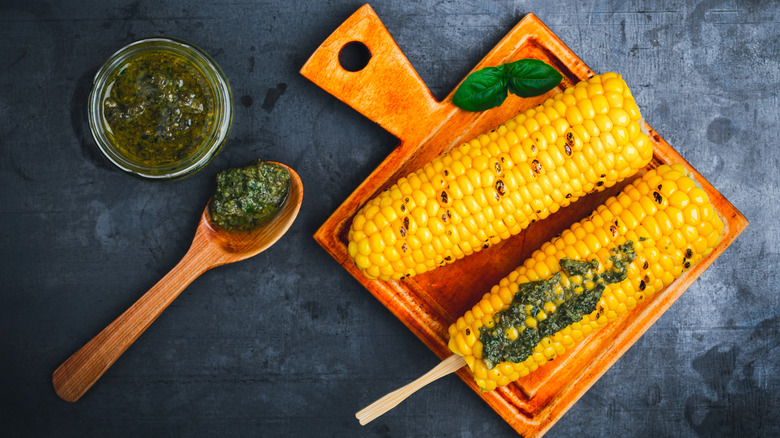Don't Throw Away Naked Corn Cobs: Milk Them For A Yummy Soup Ingredient
Corn is a foundational ingredient in many food items — tortillas, cereals, breads. And, of course, it's delicious all by itself (on the cob or off). When you're cooking ears of corn (which is actually a fruit, a grain, and a vegetable), there are many tricks for elevating this beloved foodstuff. For instance, boiling corn with the husk on is a game-changer, and your slow cooker is the secret to easy corn on the cob. While we know there are hundreds of uses for the corn itself, did you know the cob at the center of all that golden goodness is actually useful, too? For instance, you can milk corn cobs (you read that right — milk) to extract a delicious ingredient for soup and other dishes.
To get the skinny on how to milk a cob — and why on earth you would ever want to try — Food Republic turned to Kent Rollins, host of Outdoor Channel's "Cast Iron Cowboy." He shared why taking this extra step, rather than merely discarding the cobs, is worth the effort. "People tend to think of the cob as a throwaway, but that corn milk can be used to thicken soups and add a little sweetness," he shared.
Corn milk is the remaining juice that cobs hold onto once you've cut or eaten off all those yummy kernels. It's incredibly flavorful, delivering a concentrated corn taste that is sweet and will deepen the corny goodness of any dish it's added to. It's so flavor-packed, in fact, that it can replace broth and some of the dairy elements in soups and other recipes. "It's great in corn chowder, creamed corn, or corn pudding or even stirred into cornbread batter," Rollins detailed.
How to milk corn cobs
So, just how do you extract the milk from a corn cob? The process isn't difficult. "I've milked a lot of cows and a lot of corn, and the good thing about corn is it won't kick or try to run you over," Kent Rollins joked. "To 'milk' a cob, you take the back side of a knife or the handle of a metal spoon and scrape down the cob after the kernels are gone. That process releases all the sweet, starchy milk left behind." The emerging juices and pulp can be collected into a bowl, and from there you can either use all of the substance or strain out the pulp so only the milk remains.
To make the most of your milking efforts, start with fresh, high-quality corn that's in-season — your corn milk will only be as flavorful as the vegetable it comes from. Also, when you remove the kernels from the cob, don't cut all the way to the center — just take off the heads of the kernels (that's where the good stuff for eating is anyway) and leave the roots attached. The tip cap (that tougher part at the base of the kernel that attaches to the corn husk) is the obnoxious bit that wedges between your teeth when you eat corn on the cob. If you leave it attached instead of eating it, it contributes extra juice when you harvest your corn milk.
In addition to extracting milk from them, "the cobs themselves can be simmered in soups or broth to boost flavor," Rollins shared. And their use goes even further. "[Once] they're dried out, they even make excellent kindling for a fire," he added.


